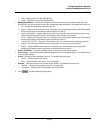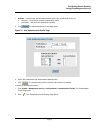
D-Link DES-3010FA/GA User Guide
Page 70
Defining Authentication Profiles
Authentication profiles allow network administrators to assign authentication methods for user authentication.
User authentication can be performed locally or on an external server. User authentication occurs in the order the
methods are selected. If the first authentication method is not available, the next selected method is used. For
example, if the selected authentication methods are RADIUS and Local, and the RADIUS server is not available,
then the user is authenticated locally. To define Authentication profiles:
1. Click System > Management Security > Authentication > Authentication Profiles. The Authentication
Profile Page opens.
Figure 30: Authentication Profile Page
The Authentication Profile Page contains the following fields:
• Profile Name — User-defined authentication profile lists to which user-defined authentication profiles are
added.
• Methods — Defines the user authentication methods. The possible field values are:
– None — Assigns no authentication method to the authentication profile.
– Local — Authenticates the user at the device level. The device checks the user name and password for
authentication.
– RADIUS — Authenticates the user at the RADIUS server. For more information, see ““Defining RADIUS
Settings” on page 75."
– Line — Authenticates the user using a line password.
– Enable — Authenticates the user using an enable password.


















